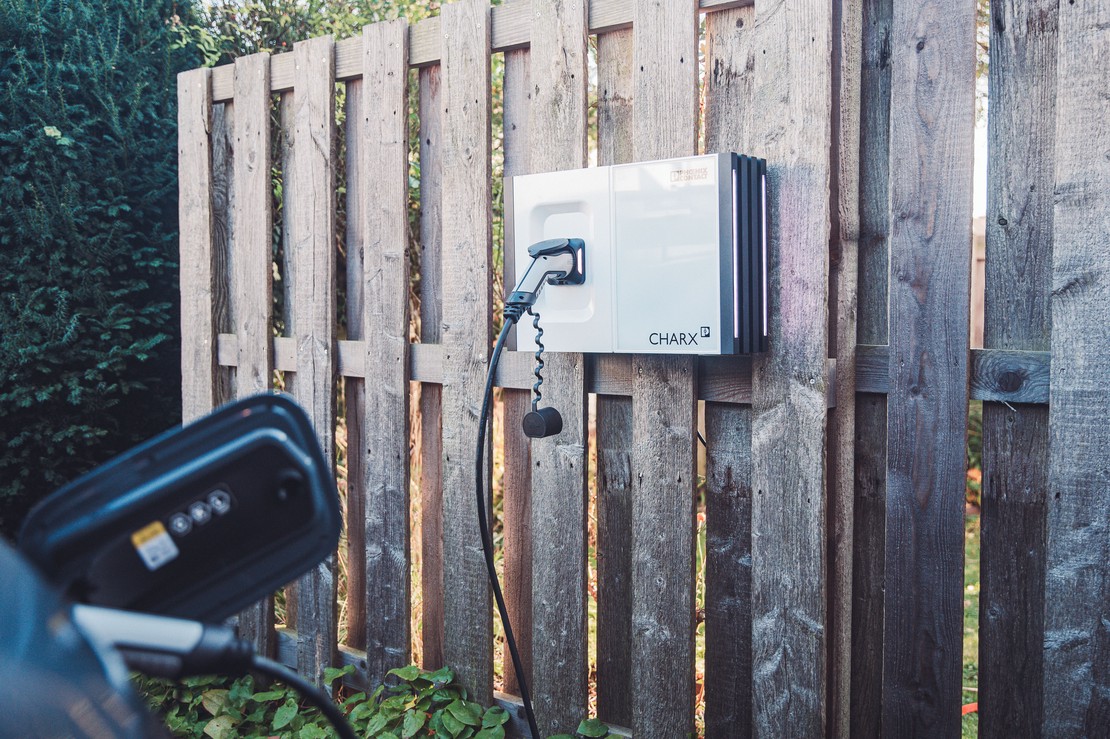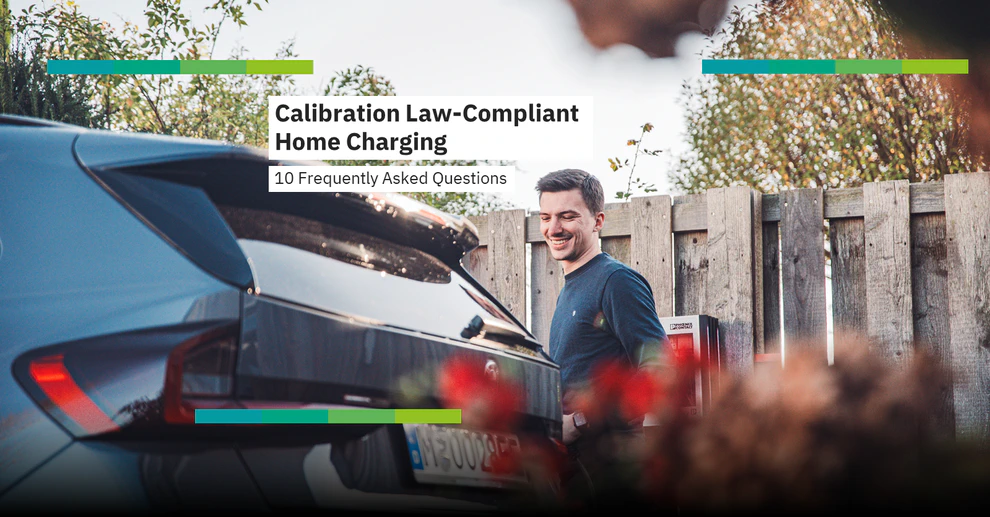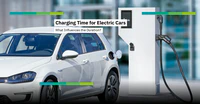In Germany, there are numerous laws and regulations that govern daily life, and charging electric vehicles at home is no exception. Especially in the area of company cars, it is crucial that the billing of the charged electricity is transparent and accurate. In various conversations, questions about calibration law-compliant charging frequently arise. To provide you with a comprehensive overview and to clear up common uncertainties, we have answered the ten most frequently asked questions on this topic.
Is the Charge Repay Service calibration law-compliant?
We often get asked whether our Charge Repay Service is calibration law-compliant. The Charge Repay Service enables calibration law-compliant billing. This means that any wallbox, regardless of whether it is used by multiple users or was originally not calibration law-compliant, can be used for billing with the company. In the Charge Repay Service web app, users can classify their charging sessions as private or business-related, thus billing the electricity in a calibration law-compliant manner with the company.
10 Frequently Asked Questions about Calibration Law in the Home Area
1. What does calibration law-compliant charging mean?
Calibration law-compliant charging means that the measuring devices in charging stations or the charging station itself comply with legal requirements and are accordingly certified. The legal requirements for calibration law-compliant charging are specified (in Germany) in the Measurement and Calibration Act (MessEG ) and the Measurement and Calibration Ordinance (MessEV ). This ensures that the billed amount of electricity corresponds exactly to the amount actually charged. It is comparable to the calibration mark on a beer glass, which ensures that the amount in the glass is correct. In our blog post, you will find everything about calibration law in the Charge@Home area .
2. Why is calibration law-compliant home charging relevant for company cars?
Calibration law-compliant home charging is important to ensure transparency and fairness in the billing of charged electricity, especially in the context of company cars. It protects both company car drivers and the company from potential billing errors and manipulations. This is particularly significant for company car drivers who bill the charged electricity to their employer. It can be used as legally secure proof of performance for tax authorities.
3. Is calibration law-compliant home charging necessary? Isn’t a MID meter sufficient?
A MID meter is sufficient for many private applications as it also allows for accurate measurements. For company cars, a MID meter is also sufficient as long as only the company car is charged at this wallbox. However, if other vehicles are to be charged at the wallbox, a calibration law-compliant wallbox is required. A MID meter does not meet all the requirements of calibration law concerning the application in the field of electromobility, particularly not the tamper-proof storage and transmission of data. If another vehicle is to be charged, a “simple” wallbox can be upgraded with the Charge Repay Service to enable a calibration law-compliant distinction between company cars and other electric vehicles. We have also written a detailed blog post on this topic: Retrofitting MID meters or calibration law-compliant wallboxes?
Download our charge@home Guide now!
Our guide highlights the requirements for a home charging solution and explains what is needed to use it for legally compliant billing of company cars. Learn more about the installation of wallboxes, legal frameworks, and efficient billing solutions for home charging.
REQUEST GUIDE
4. What requirements must calibration law-compliant charging stations meet?
Calibration law-compliant charging stations must be tested and certified by a certified body. In Germany, this is done by the Physikalisch-Technische Bundesanstalt (PTB), the Association for Electrical, Electronic & Information Technologies (VDE), and others. They ensure that the charging stations comply with legal requirements and operate reliably. Additionally, the production by the manufacturer must also be certified to ensure compliance with all legal requirements and to ensure that each individual wallbox corresponds to the certified model.
5. How do I recognize if a charging station is calibration law-compliant?
Calibration law-compliant charging stations are usually marked with a corresponding certificate or seal (NOTE: This is not mandatory and not legally protected). They should also be indicated as calibration law-compliant in the technical specifications. Look for indications such as “calibration law-compliant” or “conformity assessed” in the product descriptions.
6. What is the difference between calibration law-compliant and non-calibration law-compliant charging stations?
The main difference lies in accuracy and legal approval. Calibration law-compliant charging stations are legally tested and offer accurate and transparent billing (within tolerances), while non-calibration law-compliant charging stations do not necessarily meet these requirements. Non-calibration law-compliant charging stations, for example, may not be able to record and store the charged amount of electricity in a tamper-proof manner.
7. How does billing work with calibration law-compliant charging stations?
Billing is based on the actual kilowatt-hours (kWh) charged. The measurement values are securely stored and can be checked at any time to ensure transparent and fair billing. The data is recorded in a tamper-proof manner and transmitted to a backend system that performs the billing. We have summarized more information on this topic here: Charging and billing company cars at home .

8. Müssen eichrechtskonforme Wallboxen regelmäßig nachgeeicht werden?
Ja, eichrechtskonforme Wallboxen müssen regelmäßig nachgeeicht werden, um sicherzustellen, dass die Messungen weiterhin genau sind. Die Intervalle für die Nachprüfung werden von den zuständigen Behörden festgelegt und können je nach Gerät und Nutzung variieren. In den meisten Fällen ist eine Nacheichung in der Installation unter wirtschaftlichen Aspekten nicht sinnvoll und ein Austausch mit einem neuen Modell ist notwendig. Nutzt man einen separaten MID-konformen Zwischenzähler oder die Nachrüstungsmöglichkeit des Charge Repay Services von Phoenix Contact, muss lediglich der MID-Zähler getauscht werden. Die Wallbox kann weiterverwendet werden.
8. Do calibration law-compliant wallboxes need to be recalibrated regularly?
Yes, calibration law-compliant wallboxes need to be recalibrated regularly to ensure that the measurements remain accurate. The intervals for recalibration are set by the relevant authorities and can vary depending on the device and usage. In most cases, recalibration on-site is not economically feasible, and replacing the wallbox with a new model is necessary. If a separate MID-compliant intermediate meter or the retrofit option of the Charge Repay Service from Phoenix Contact is used, only the MID meter needs to be replaced. The wallbox can continue to be used.
9. What are the benefits of calibration law-compliant charging for companies?
Companies benefit from the transparency and accuracy of billing, leading to better cost control. Additionally, it strengthens the trust of employees, as they can be sure that the billing is correct. Most importantly, it provides legally secure proof to tax authorities, as it is a tax-free reimbursement to the employee.
10. What costs are associated with calibration law-compliant charging stations?
The costs for calibration law-compliant charging stations can be higher than for non-calibration law-compliant models, as they require additional testing and certifications. A calibration law-compliant AC wallbox (11 kW or 22 kW) starts at around 1500 euros, while high-quality models with two charging points can cost up to 4500 euros. However, in the long run, they can save costs through accurate billing and the avoidance of billing errors. A MID meter is much more cost-effective and, with the Charge Repay Service retrofit, is not disadvantageous in terms of flexibility and convenience.
Conclusion
Calibration law-compliant home charging is particularly essential for company car drivers, as it ensures precise and tamper-proof billing of the charged electricity. For private electric vehicles, a calibration law-compliant wallbox is not mandatory but can provide additional security and transparency. Despite higher initial costs for calibration law-compliant charging stations, the investment pays off in the long run by avoiding billing errors and complying with legal requirements. However, there are also alternatives to the costly calibration law-compliant wallbox. The Charge Repay Service combines legal security with a cost-effective and flexible solution. With the right knowledge and the appropriate equipment, everyone can benefit from the advantages of calibration law-compliant charging and contribute to a fair and transparent future of electromobility.




